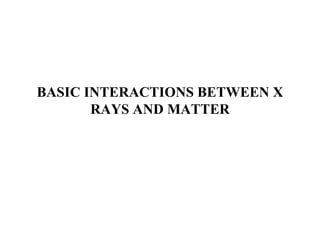BASIC INTERACTIONS BETWEEN X RAYS AND MATTER.ppt
•Descargar como PPT, PDF•
0 recomendaciones•16 vistas
X-rays can interact with matter through several interactions, the most significant in diagnostic radiology being coherent scattering (Rayleigh scattering and Thomson scattering) and Compton scattering. In Rayleigh scattering, photons are scattered by bound electrons in an atom without exciting or ionizing the atom. In Compton scattering, a high energy photon collides with and ejects a loosely bound electron, becoming deflected and losing some energy. The patient's body is the main source of scattered radiation during an x-ray procedure, degrading image quality and increasing radiation exposure to personnel.
Denunciar
Compartir
Denunciar
Compartir

Recomendados
Recomendados
Más contenido relacionado
Similar a BASIC INTERACTIONS BETWEEN X RAYS AND MATTER.ppt
Similar a BASIC INTERACTIONS BETWEEN X RAYS AND MATTER.ppt (20)
Interactions of X-ray & matter & Attenuation - Dr. Sayak Datta

Interactions of X-ray & matter & Attenuation - Dr. Sayak Datta
Chap1 physics and chemistry of radiation absorption

Chap1 physics and chemistry of radiation absorption
02 x ray production and its interaction with matter

02 x ray production and its interaction with matter
Más de ranjitharadhakrishna3
Más de ranjitharadhakrishna3 (20)
Sarcoidosis radiology pulmonary neuro abdominal .ppt

Sarcoidosis radiology pulmonary neuro abdominal .ppt
Último
Último (20)
THE ROLE OF BIOTECHNOLOGY IN THE ECONOMIC UPLIFT.pptx

THE ROLE OF BIOTECHNOLOGY IN THE ECONOMIC UPLIFT.pptx
Biogenic Sulfur Gases as Biosignatures on Temperate Sub-Neptune Waterworlds

Biogenic Sulfur Gases as Biosignatures on Temperate Sub-Neptune Waterworlds
GBSN - Microbiology (Unit 3)Defense Mechanism of the body 

GBSN - Microbiology (Unit 3)Defense Mechanism of the body
300003-World Science Day For Peace And Development.pptx

300003-World Science Day For Peace And Development.pptx
LUNULARIA -features, morphology, anatomy ,reproduction etc.

LUNULARIA -features, morphology, anatomy ,reproduction etc.
Cyathodium bryophyte: morphology, anatomy, reproduction etc.

Cyathodium bryophyte: morphology, anatomy, reproduction etc.
Human & Veterinary Respiratory Physilogy_DR.E.Muralinath_Associate Professor....

Human & Veterinary Respiratory Physilogy_DR.E.Muralinath_Associate Professor....
Thyroid Physiology_Dr.E. Muralinath_ Associate Professor

Thyroid Physiology_Dr.E. Muralinath_ Associate Professor
FAIRSpectra - Enabling the FAIRification of Spectroscopy and Spectrometry

FAIRSpectra - Enabling the FAIRification of Spectroscopy and Spectrometry
Call Girls Ahmedabad +917728919243 call me Independent Escort Service

Call Girls Ahmedabad +917728919243 call me Independent Escort Service
Climate Change Impacts on Terrestrial and Aquatic Ecosystems.pptx

Climate Change Impacts on Terrestrial and Aquatic Ecosystems.pptx
Role of AI in seed science Predictive modelling and Beyond.pptx

Role of AI in seed science Predictive modelling and Beyond.pptx
GBSN - Biochemistry (Unit 2) Basic concept of organic chemistry 

GBSN - Biochemistry (Unit 2) Basic concept of organic chemistry
BASIC INTERACTIONS BETWEEN X RAYS AND MATTER.ppt
- 1. BASIC INTERACTIONS BETWEEN X RAYS AND MATTER
- 2. Atoms are bound into molecules by electrons in the outermost shell.x ray photons interact either with the orbital electrons or with the nucleus In the diagnostic range, the interactions are with orbital electrons Interaction between X-rays and matter •Coherent Scattering •Photoelectric effect •Compton Scattering •Pair Production •Photodisintegration
- 6. Low energy photons,only scattering,no ionisation and only little energy loss,
- 7. • Two types of coherent scattering • Thomson scattering-a single electron is involved in the interaction • Rayleigh scattering-results from a cooperative interaction with all electrons of an atom
- 8. • Rayleigh Scattering (Coherent Scattering) 1 . Photons are scattered by bound electrons 2. Atoms are neither excited or ionized 3. Scattering from different parts of electron cloud - coherent scattering
- 10. The tighter an electron is bound,more likely it is involved in photoelectric reaxn
- 14. • The charecteristic radiation– secondary radiation • Only iodine and barium in diagnostic radiology emit charecteristic radiation energetic enough to leave the patient and fog film • Application of photoelectric effect-produces images of good quality becoz there is no scatter and it enhances tissue contrast • But patient gets more radiation
- 15. Compton scattering • Almost all scatter in diagnostic radiology comes from compton scatter • Rel high energy incident photon strikes a free outer shell electron and ejects it • The photon is deflected.part of its energy goes to the electron.rest is retained.the amount retained dep on initial energy and angle of deflection off the electron • At narrow angles of deflection,the scattered photon retains more of its org energy
- 17. Compton scatter
- 19. The most significant object producing scattered radiation in an x-ray procedure is the patient's body. The portion of the patient's body that is within the primary x-ray beam becomes the actual source of scattered radiation. This has two undesirable consequences. The scattered radiation that continues in the forward . direction and reaches the image receptor decreases the quality (contrast) of the image; the radiation that is scattered from the patient is the predominant source of radiation exposure to the personnel conducting the examination.
- 21. Pair production and photo disintegration do not occur in diagnostic energy range A photon with Energy > 1.02Mev might completely disappear under the production of an electron and a positron (electron with positive charge) Pair production